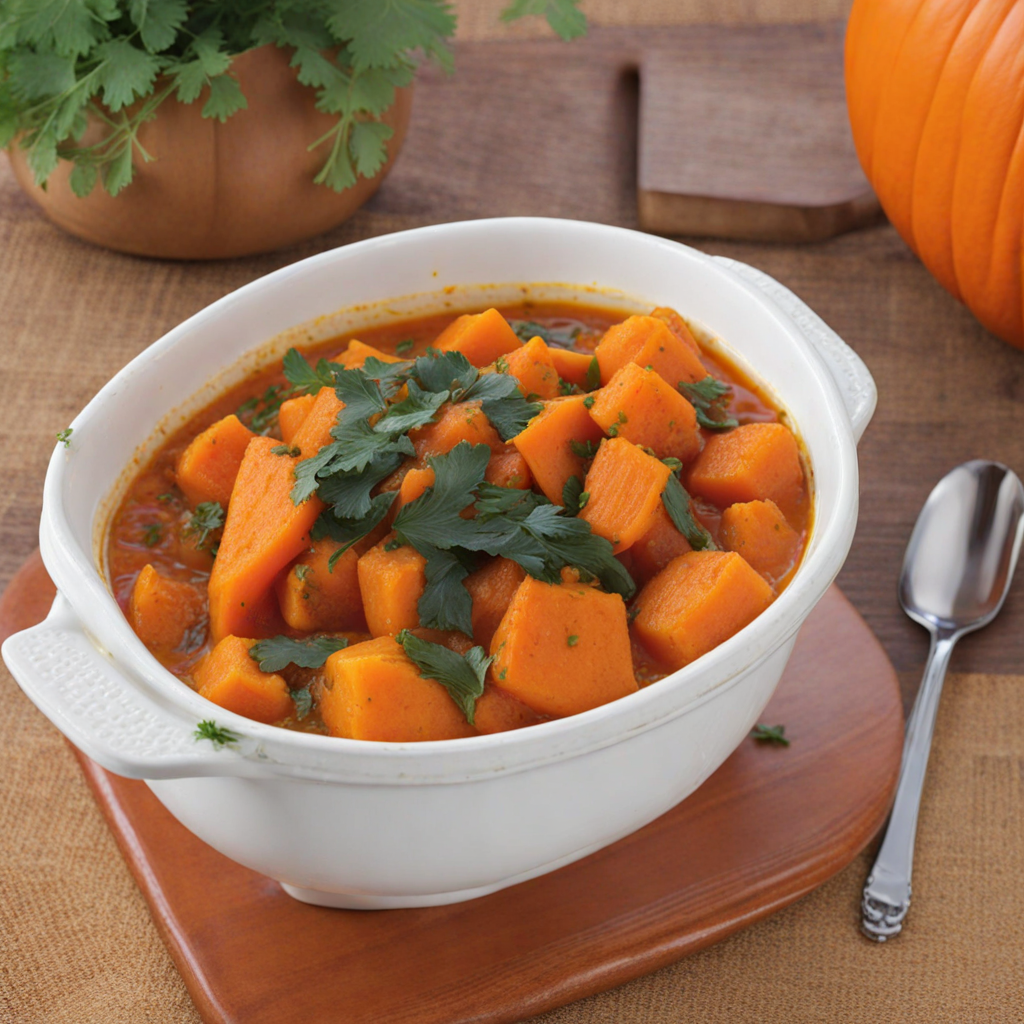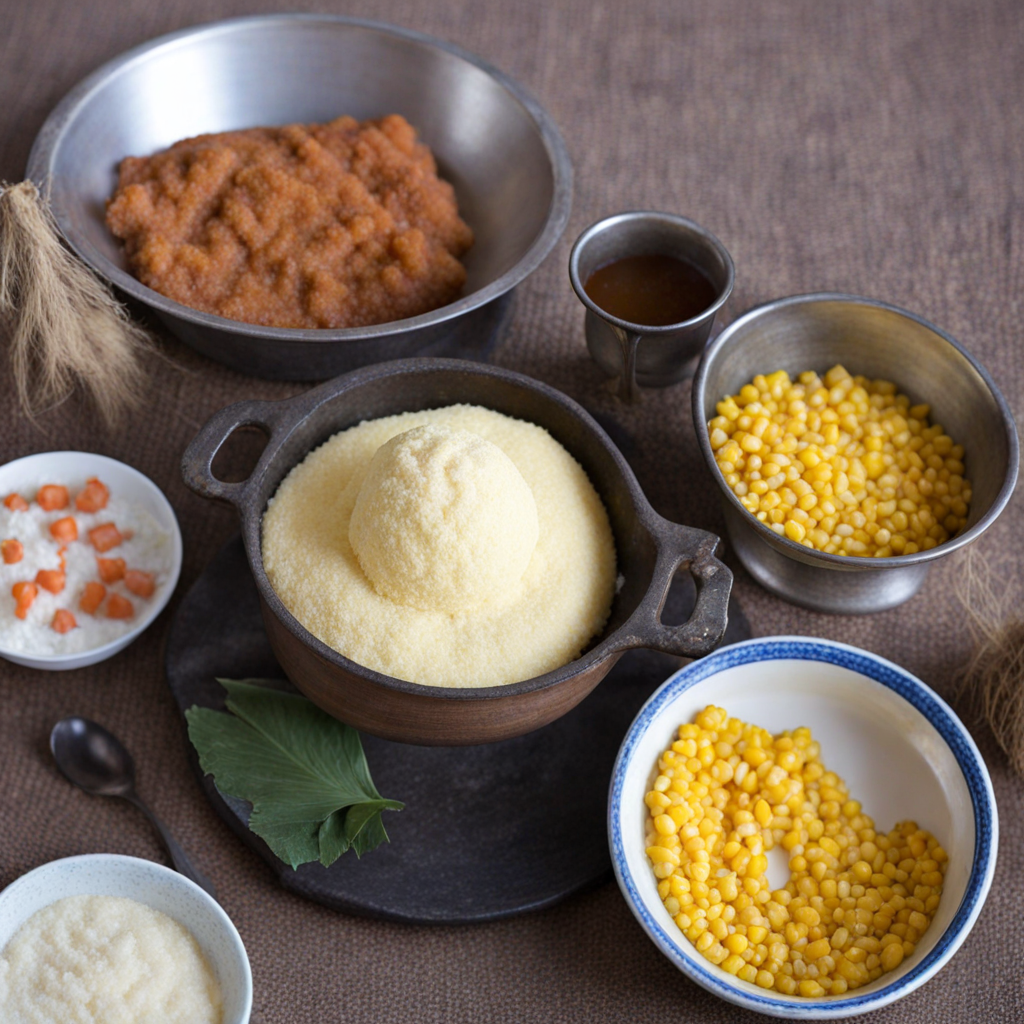Ibihaza na Karoti
Ibihaza na Karoti is a delightful Rwandan dish that showcases the rich flavors of pumpkin and carrots, creating a comforting and nutritious meal. The main ingredient, ibihaza, refers to the local variety of pumpkin, which is known for its sweet, earthy flavor and vibrant orange hue. Combined with finely chopped carrots, this dish not only offers a beautiful color palette but also a delightful balance of textures. The pumpkins are typically boiled or steamed until tender, allowing their natural sweetness to shine, while the carrots add a subtle crunch and a hint of sweetness. What makes Ibihaza na Karoti truly special is the way it is seasoned. Traditional spices, often including garlic, ginger, and sometimes a touch of chili, are used to enhance the dish's flavor profile. A drizzle of vegetable oil or a pat of butter adds richness, making each bite satisfying. The dish is often finished with a sprinkle of fresh herbs, such as parsley or coriander, which adds a refreshing contrast to the warm, comforting elements of the pumpkin and carrots. This dish is often served as a side alongside staples like rice or ugali, but it can also stand alone as a vegetarian main course. The combination of flavors and textures makes Ibihaza na Karoti not only a nutritious option but also a versatile dish that can be enjoyed by everyone. Its simplicity and heartfelt preparation reflect the essence of Rwandan cuisine, inviting you to savor the wholesome taste of local ingredients.
How It Became This Dish
Ibihaza na Karoti: A Culinary Journey through Rwanda's Cultural Heritage Origins of Ibihaza na Karoti Ibihaza na Karoti, a traditional Rwandan dish made primarily from pumpkin (ibihaza) and carrots (karoti), embodies the rich agricultural heritage and culinary practices of Rwanda. The name itself translates to "pumpkin and carrots," reflecting the dish's simple yet nourishing ingredients. The history of this dish is intrinsically tied to Rwanda's agricultural practices, as both pumpkins and carrots thrive in the country's fertile volcanic soils, particularly in regions like Musanze and Nyamagabe. Pumpkins are known to have been cultivated in Africa for thousands of years, tracing back to the time of early agricultural societies. Rwandan farmers have traditionally grown pumpkins not only for their nutritional value but also for their versatility. Carrots, introduced to Africa during the 19th century, quickly became a staple due to their adaptability to local climates and soils. The combination of these two vegetables in Ibihaza na Karoti represents the synergy of indigenous agricultural practices with introduced crops, showcasing Rwanda's evolving food landscape. Cultural Significance In Rwandan culture, food is more than sustenance; it is a vital part of social interactions, cultural identity, and community bonding. Ibihaza na Karoti is often prepared during communal gatherings, family celebrations, and significant events, symbolizing unity and togetherness. The act of cooking and sharing this dish embodies the Rwandan values of hospitality and kinship. Pumpkin, in particular, holds a special place in Rwandan culture. It is often associated with harvest festivals and is a key ingredient in traditional ceremonies, representing abundance and gratitude. Carrots add color and nutrition, reflecting the importance of a balanced diet, especially in a country where food security has been a concern. The preparation of Ibihaza na Karoti also allows for intergenerational knowledge transfer, as recipes and cooking methods are passed down from elders to younger generations, thus preserving cultural heritage. Development Over Time Historically, Rwandan cuisine was characterized by the use of locally available ingredients, and dishes were often simple, emphasizing freshness and flavor. Ibihaza na Karoti is no exception; it has evolved over time while remaining rooted in its traditional origins. In the past, this dish might have been prepared in a more rustic manner, using basic cooking techniques such as boiling or steaming. With the influence of globalization and the introduction of modern cooking appliances, the preparation of Ibihaza na Karoti has seen some changes. Today, many Rwandans might opt for faster cooking methods, such as pressure cooking or sautéing, to save time while preserving the dish's essential flavors. This shift is indicative of a broader trend seen across the globe, where traditional recipes adapt to modern lifestyles without losing their cultural essence. In recent years, there has been a growing emphasis on nutrition and health in Rwanda, prompting a revival of interest in traditional dishes like Ibihaza na Karoti. Efforts to promote sustainable agriculture and food sovereignty have led to increased awareness of the nutritional benefits of indigenous crops. As a result, Ibihaza na Karoti has gained recognition not only as a delicious meal but also as a symbol of healthy eating practices. Many Rwandan chefs and home cooks are experimenting with the dish, incorporating spices and other vegetables to enhance its flavor and nutritional profile. Contemporary Interpretations In contemporary Rwandan cuisine, Ibihaza na Karoti has found its way into various culinary settings, from home kitchens to upscale restaurants. Chefs are reinterpreting the dish by adding local spices, herbs, or even proteins like beans or meat, creating a fusion of traditional and modern flavors. This evolution reflects the dynamic nature of Rwandan gastronomy and the willingness to embrace innovation while honoring tradition. The dish has also gained popularity in Rwandan diaspora communities, where it serves as a culinary bridge to home. For many Rwandans living abroad, preparing Ibihaza na Karoti evokes nostalgia and a sense of belonging, allowing them to connect with their roots and share their heritage with others. Cooking and sharing this dish in diaspora settings can foster community and solidarity among Rwandans, reinforcing cultural identity in a new context. Ibihaza na Karoti in the Global Context As global interest in diverse cuisines grows, Ibihaza na Karoti has started to make its mark beyond Rwanda's borders. Food enthusiasts and chefs worldwide are increasingly recognizing the importance of traditional African dishes in the broader narrative of global cuisine. Social media and food blogs have played a significant role in promoting Rwandan culinary traditions, and Ibihaza na Karoti has garnered attention as a nutritious and flavorful dish that reflects Rwanda's agricultural bounty. The dish's simplicity and wholesome ingredients make it appealing to health-conscious eaters, especially in an age where plant-based diets are gaining traction. As more people seek out authentic and sustainable food experiences, Ibihaza na Karoti stands out as a symbol of Rwandan culinary heritage, appealing to both locals and international audiences alike. Conclusion Ibihaza na Karoti is more than just a dish; it is a narrative of Rwanda's agricultural practices, cultural values, and evolving culinary landscape. From its origins in local fields to its place at communal tables, this dish encapsulates the spirit of Rwandan hospitality and the resilience of its people. As Ibihaza na Karoti continues to evolve, it remains a potent reminder of the importance of food in fostering connections, preserving cultural identity, and embracing the future with an appreciation for the past. In every bowl of this vibrant dish lies a story—a story of heritage, community, and the enduring power of food to bring people together.
You may like
Discover local flavors from Rwanda







